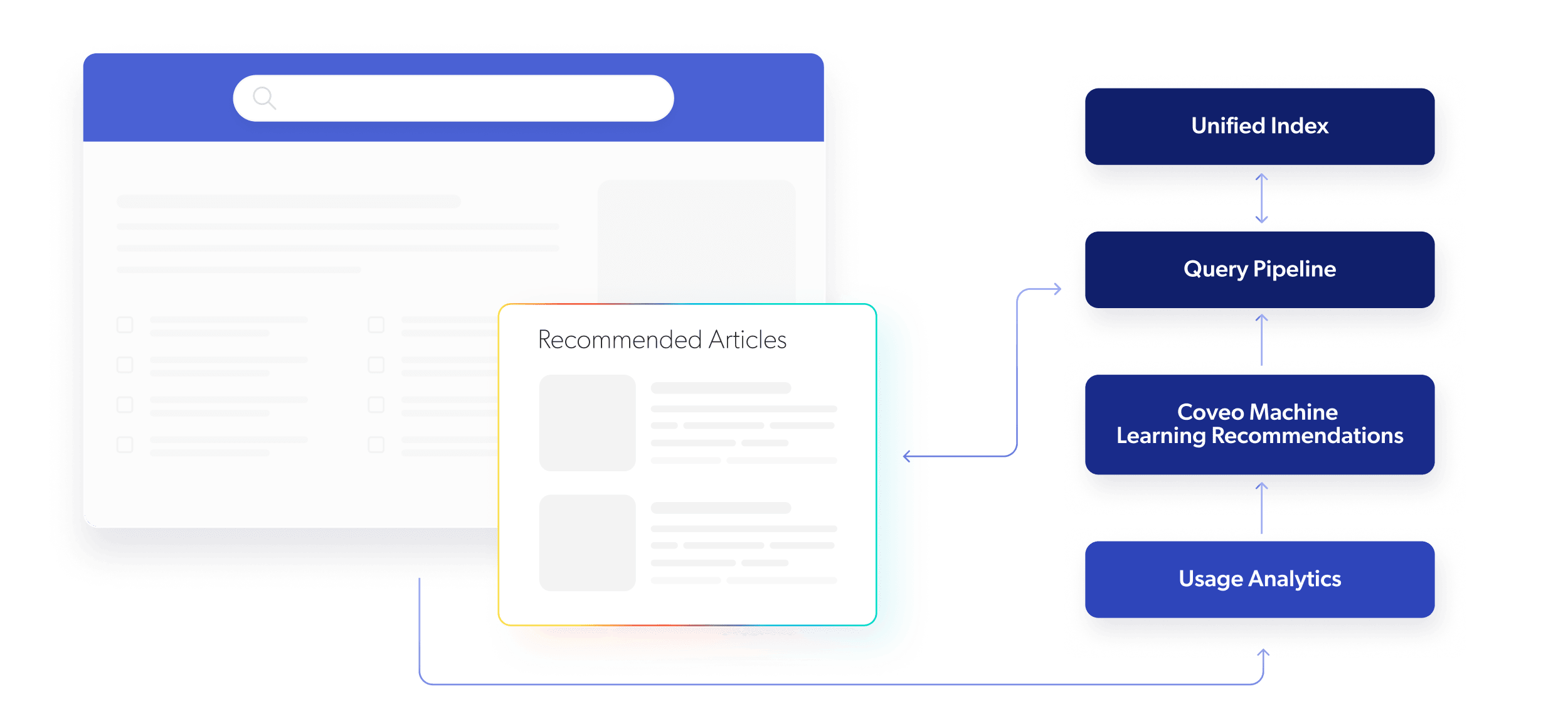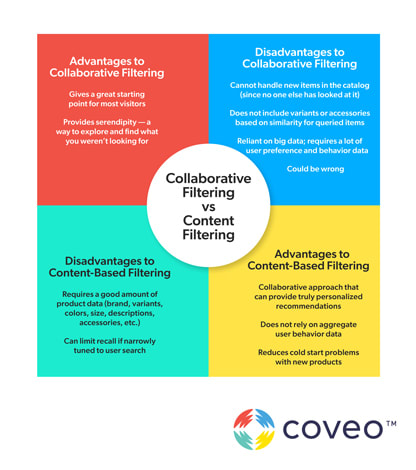From TikTok to Netflix, Spotify to LinkedIn, you’ll find recommender systems in use across the digital landscape. Why? With the help of machine learning and artificial intelligence, a recommendation system can make almost any website, ecommerce experience, or app feel like a personalized concierge.
What Is A Recommender System?
A recommender system (also referred to as a recommendation engine) uses machine learning and data filters to organize search results in a way that is most relevant to the end-user. The order of search results can be based on user preferences, behaviors, or other relevant factors.
Coveo organizes its recommender system into two high-level categories:
- Product Recommendation (PR): Recommends products that suit a visitor’s profile, context, and buying behaviors.
- Content Recommendation (CR): Recommends the most relevant content for each user with machine learning models that continuously learn from clicks, views, and other engagement signals.
Why are recommender systems so important? They can drastically reduce friction across the customer journey. According to the 2024 Customer Experience (CX) Industry Report from Coveo, friction comes in many forms — forms that a recommender system can mitigate:
- Too many choices, difficult to filter or irrelevant filtering options (35%)
- Difficult to find what I wanted using search or browse (32%)
- Irrelevant recommendations not personalized to my preferences (25%)
Because they can show product and content recommendations in any webpage, community, marketplace, or digital property, recommender systems stand to drastically reduce friction by seamlessly guiding users from retrieval to discovery. It can help people solve problems faster by displaying related support articles, videos, and community posts, for example: 33% of respondents to the CX Industry Report said getting recommendations for content that has been helpful to others with a similar problem would improve their digital experience.
Recommendations can improve click-through with auto-populated suggestions and predictive offers, too, as well as maximize cart value with trending, frequently bought together, buy-again, and other recommendation strategies: 45% of website visitors are motivated by customer reviews, recommendations for complementary items, or “# people have bought this” displays.
How Does a Recommender System Work?
A recommender system typically relies on advanced search and one or more AI models to analyze aggregate and individual user data. It uses this information to deliver the most relevant content and products to a given visitor. However your recommender system is built, it will require as much content and user data as possible to continuously learn and refine its personalized recommendations.
This data can include:
- User behavior, user preference, user item interaction
- Search query data
- Content index
Here’s a visual representation of how Coveo’s recommender system continuously refines its recommendations based on machine learning, usage analytics, and other data sources:

The Commerce Use Case
It probably doesn’t surprise you that more than a third of Amazon’s purchases are a result of product recommendations. Whether you are aware of it or not, a recommendation engine using content-based filtering has most likely been your shopping companion every time you have completed a purchase online.
But products are not the only items a recommendation system can suggest. Machine learning leverages user data to serve up relevant content throughout workplaces, social media, and customer service sites.
Recommendations can be made at any time:
- From the moment you log onto a site (ala Netflix)
- In the search bar (with drop-down suggestions)
- After you have added something to your cart (i.e., you might like this, too!)
- In ranking algorithms that produce custom search results based on your user profile and past, user interaction events, and other data (such as when you search your company’s intranet or website)
In fact, a whopping 80% of entertainment consumed on Netflix is because of its content recommender system. That shouldn’t be surprising, says Louis Têtu, CEO of Coveo. “Netflix wants you watching — not searching.”
Predictions Based on Ratings
The easiest way to think of a recommender system is like a ratings engine. The higher the rating the more likely it will be “liked” by a consumer. High ratings signal highly relevant product recommendations. And while ratings can be explicit or implied, often, they are binary:
Purchase = 1 No purchase = 0
To generate meaningful, personalized product recommendations, the recommender systems must have a fair amount of data to determine a recommendation strategy. That data is then filtered accordingly so that users are exposed to the most relevant product they are most likely to buy.
So, what kinds of data will predict behaviors? Previous buyers’ histories is one of the most common types of data. But good recommender systems should not stop there. You can use contextual, business-related, user profile-based, product-based, or content-based data.
Really, any type of data can be added. (In fact, here are the five categories of recommendation elements that can be offered.)
But once you have the data, then what?

Collaborative Filtering Recommender Systems
Many recommender systems, such as Amazon’s and Netflix’s, work by using artificial intelligence models to aggregate the behavior histories of all of their shoppers. They analyze that data so that the system can predict the behavior of what similar users have done in the past.
In marketing, this is called “persona-based personalization.” Whereas in data science and computer science, researchers call this “collaborative filtering.”
Advantages to Collaborative Filtering
- Gives a great starting point for most visitors
- Provides serendipity — a way to explore and find what you weren’t looking for
Disadvantages to Collaborative Filtering
- Cannot handle new items such as products or information (since no one else has looked at it)
- Does not include variants or accessories based on similarity for queried items
- Reliant on big data; requires a lot of user preference and behavior data
- It also may turn out to be just plain wrong
Collaborative filtering systems/persona-based merchandising works… kind of. It can also introduce a lot of noise.
For example:
I once bought a unicorn blanket for a friend’s new baby from an online retailer. Now, I am constantly deluged with unicorn-themed baby items — across all of my devices. Luckily, there are other ways to provide a user with accurate recommendations that have a positive impact on the shopper experience.
Content-Based Filtering: Reduce the Annoyance of Unwanted Products
The best recommendation engines avoid annoying customers in this way through content-based filtering. This real-time analysis of a shopper’s behavior offers the most precise and personalized way to handle relevant recommendations.
Prior user history is considered but is weighted much lower than what a shopper is doing while in the current shopping session. With a content recommendation engine, everything a shopper or visitor is looking at counts, including product attributes such as size, description, color, and price point. All of this is funneled by the algorithm into compiling similar products more likely to be added to the cart and purchased.
An effective content-based system is like an astute personal shopper. The customer is happy because it is easier to make smarter choices, faster. And the retailer is happy because the recommendation has driven more sales by pointing the customer to a recommended item or similar item they might have otherwise missed. Using AI recommendations, Caleres increased search conversion rate by 25%. River Island increased revenue per visitor by 6.15%.
Advantages to Content-Based Filtering
- Collaborative approach that can provide truly personalized recommendations
- Does not rely on aggregate user behavior data
- Reduces cold start problems with new products
Disadvantages to Content -Based Filtering
- Requires a good amount of product data (brand, variants, colors, size, descriptions, accessories, etc.)
- Can limit recall if narrowly tuned to user search
Hybrid Recommender System
Recommendation algorithms don’t just feed on data about user behavior, though. As I noted before, they also savor all of the rich information in product catalogs and descriptions – plus all the business data you might want to further tweak the results.
For example, if you are selling women’s golf slacks, size 4, the attributes of the slacks you have selected are identified.
Womens, size 4, golf, slacks
If you then were to search for gloves, the prior attributes would dynamically order the autosuggest to:
Sporting gloves → golf
And if you were really savvy, you could also add in margin data, so that the slacks that have the greatest margin are weighted higher in the results!
Relevant Reading: 17 Elements of a Product Recommendation Strategy
Machine Learning Recommendations
Traditionally, creating a recommendation system has been a highly manual process involving intensive analysis of shoppers’ behavior that then gets hard coded into an algorithm. Think of it as “if-then” situations from school tests. The thinking goes that, if shoppers buy baby blankets, then they may want to buy another similar product.
The recommendation algorithm or set of rules may work sometimes (although not all of the time, per my unicorn baby example from above, or this poor person’s struggle with toilet seats). However, it’s not unusual for legacy systems to have literally thousands of algorithms. And you likely won’t know when they conflict.
The best recommendation engine then is based on advanced machine learning algorithms, says Simon Langevin, director of product management for Coveo.
The Coveo recommendation engine can employ a wide range of AI models that cover the full spectrum of machine learning, deep learning, large language, and generative AI models:
Behavioral machine learning models
- Query suggestions
- Automatic relevance tuning
- Dynamic navigation experience
- Content recommendations
- Product recommendations
- Listing page optimizer
Deep learning models
- Predictive query suggestions
- Intent-aware product ranking
- Session-based product recommendations
- Business-aware product ranking
LLMs and generative models
- Semantic encoder
- Smart snippets
- Case assist
- Generative answering
Machine learning algorithms open the door to a host of strategies that help visitors discover more of a product catalog, while engaging them with recommended products personalized for their unique journey.
For example, you can recommend trending or frequently-bought-together items. You can display product recommendations that could help a visitor complete their job (if they’ve selected caulk, for example, you can recommend a suitable caulk gun).
You can also recommend complimentary content throughout each journey, such as related blog posts or DIY advice. If a visitor has added all ingredients for a beef bourguignon into their cart, they might benefit from seeing a beef bourguignon recipe, for example.
Intent-aware recommendations
A deep learning recommendation model can react and adjust in real-time. The truth is, recommending popular items will only get you so far. A deep learning recommendation model can recognize a visitor’s true intent and tap into a full product catalog (including new and long-tail products) to make the best recommendations.
What About Search Experiences and Support?
Commerce may be the most prominent use case for recommender systems, but it’s not the only one. Just as you can recommend products to site visitors, you can also recommend answers, guidance, and solutions.
We know that when visitors have questions or problems, they often turn to search. Using much of the same machine learning and AI technology, you can infuse your search experience with personalized, context-aware content that drives the user experience.
Coveo’s AI-powered query suggestions are a good example. Query suggestions make search more intelligent by:
- Learning from user behavior so that the most relevant results are presented
- Guiding users to the information they need (including similar items)
- Making contextually relevant recommendations
Given the similarities in functionality and underlying technology, query suggestions and recommender systems tend to overlap in terms of purpose and outcome. Both stand to enrich and personalize the experience across a variety of journeys, including ecommerce and customer support.
The Future of Recommendation Systems
It’s only recently that machine learning has enabled recommendation engines that can suss out these more subtle relationships. With natural language processing and understanding, it’s possible to “vectorize” a product catalog. You can see dynamic auto suggestions in detail by checking out how to grow a product tree.
Understanding the product catalog is ideal when launching a new product, line of business, website or app. If, for example, your retailing website has a new, cutting-edge TV that’s debuting, you want it to show up in recommendations before shoppers have bought or even browsed it. This is a great solution to the cold-start problem.
Content-based filtering on product catalogs are so useful, in fact, that recommendation engine algorithms can work solely on catalog information when there’s an absence of user behavior.
Of course we don’t advise that. A hybrid filtering approach is best, because all that rich buyer history from all touch points should never go to waste!
Want to start creating more personalized recommendations? Learn how Coveo delivers relevance in commerce.
Dig Deeper
Learn more about what makes a great recommendation engine in this 6-minute read.
Looking for a recommendation engine? Learn all about The Recommendation Periodic Table.
Ready to test out a collaborative filtering-based recommendation platform like Coveo? Try out a demo today.


